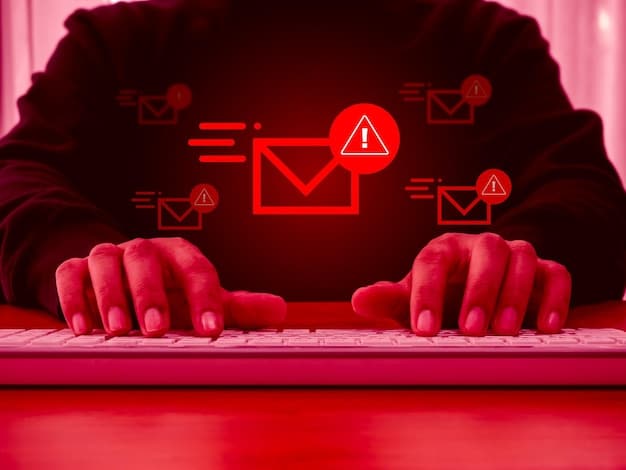Cybersecurity Threats in US 2025: Protect Yourself Now

Cybersecurity threats, especially phishing and malware, will continue to evolve in the US by 2025, requiring individuals and organizations to stay vigilant and implement robust strategies to protect their data and systems.
Stay ahead of the curve! Discover how to protect yourself from the rising cybersecurity threats: How to protect yourself from Phishing and Malware in the US in 2025. Arm yourself with the knowledge you need to navigate the digital landscape safely.
Understanding the Evolving Cybersecurity Landscape
The digital world is constantly changing, and so are the tactics of cybercriminals. To effectively protect yourself in 2025, it’s crucial to understand the current and emerging trends in cybersecurity.
Cybersecurity in the US faces unique challenges due to its high levels of internet penetration and widespread use of digital technologies. As we move closer to 2025, expect to see more sophisticated attacks that target individuals, businesses, and even critical infrastructure.
Key Cybersecurity Trends to Watch For
Keeping an eye on the horizon is essential. Stay informed about the key trends that will shape the cybersecurity landscape.
- AI-Powered Attacks: Cybercriminals are increasingly leveraging artificial intelligence to automate and refine their attacks, making them more targeted and evasive.
- Ransomware-as-a-Service (RaaS): The rise of RaaS platforms lowers the barrier to entry for aspiring cybercriminals, leading to a surge in ransomware attacks.
- IoT Vulnerabilities: As more devices connect to the internet, the attack surface expands, creating new opportunities for hackers to exploit vulnerabilities in IoT devices.
- Deepfake Technology: Deepfakes can be used to create convincing but false audio and video content, which can be used in phishing campaigns and disinformation campaigns.
By understanding these trends, you can take proactive steps to mitigate the risks and protect yourself from potential threats. Investing in cybersecurity awareness training and implementing robust security measures are essential.
Recognizing and Avoiding Phishing Attacks
Phishing attacks remain one of the most common and effective methods used by cybercriminals to steal sensitive information. Understanding how to recognize these attacks is crucial.
Phishing attacks often rely on social engineering techniques to trick individuals into revealing personal or financial information. These attacks can take many forms, including email, text messages, and even phone calls.

Common Phishing Tactics
Familiarize yourself with the common tactics used in phishing attacks to better protect yourself.
- Urgent Requests: Phishing emails often create a sense of urgency, pressuring you to act quickly without thinking.
- Suspicious Links: Be wary of links in emails that lead to unfamiliar websites or ask for personal information.
- Grammar and Spelling Errors: Phishing emails often contain grammatical errors and typos, which can be a telltale sign of a scam.
- Generic Greetings: Phishing emails may use generic greetings like “Dear Customer” instead of your name.
Stay vigilant and always double-check the authenticity of any email or message before clicking on links or providing personal information. When in doubt, contact the organization directly to verify the request.
Protecting Your Devices from Malware
Malware, which includes viruses, worms, and Trojan horses, can wreak havoc on your devices and compromise your personal information. It’s essential to take steps to protect yourself from these threats.
Malware can enter your system through various channels, including infected websites, email attachments, and malicious software downloads. Once installed, malware can steal data, damage files, or even take control of your device.
Essential Malware Protection Strategies
Implementing a comprehensive malware protection strategy is crucial for safeguarding your devices and data.
- Install Antivirus Software: Use reputable antivirus software and keep it up to date to protect against the latest threats.
- Enable Firewalls: Activate firewalls on your devices to block unauthorized access and prevent malware from spreading.
- Be Careful with Downloads: Only download software from trusted sources and avoid clicking on suspicious links or attachments.
- Regularly Update Software: Keep your operating system and software applications up to date with the latest security patches to address vulnerabilities.
By taking these steps, you can significantly reduce your risk of malware infection and protect your devices from harm. Consistent vigilance and proactive security measures are key.
Securing Your Online Accounts
Your online accounts hold a wealth of personal information, making them prime targets for cybercriminals. Securing these accounts is essential for protecting your identity and privacy.
Cybercriminals often target online accounts using stolen passwords, phishing attacks, or malware. Once they gain access to your accounts, they can steal data, make unauthorized purchases, or even impersonate you online.
Best Practices for Account Security
Implement these best practices to secure your online accounts and protect yourself from unauthorized access.
- Use Strong Passwords: Create strong, unique passwords for each of your online accounts, using a combination of letters, numbers, and symbols.
- Enable Two-Factor Authentication (2FA): Enable 2FA whenever possible to add an extra layer of security to your accounts.
- Be Careful with Public Wi-Fi: Avoid using public Wi-Fi networks for sensitive transactions, as these networks are often unsecured and vulnerable to hacking.
- Regularly Monitor Your Accounts: Keep an eye on your account activity and report any suspicious transactions or unauthorized access immediately.
Regularly updating your passwords and enabling 2FA can significantly reduce your risk of account compromise. Stay proactive and vigilant in protecting your online accounts.
Staying Safe on Social Media
Social media platforms have become an integral part of our lives, but they also pose unique cybersecurity risks. Learn how to stay safe while using social media.

Social media platforms are often targeted by cybercriminals who use fake profiles, phishing scams, and malware to steal personal information or spread disinformation. It’s essential to be cautious about what you share and who you interact with online.
Tips for Safe Social Media Usage
Follow these tips to protect yourself from cyber threats while using social media platforms.
- Adjust Privacy Settings: Review and adjust your privacy settings to control who can see your posts and personal information.
- Be Wary of Friend Requests: Only accept friend requests from people you know in real life, and be cautious about clicking on links from unfamiliar profiles.
- Avoid Oversharing: Be mindful of the information you share on social media, as cybercriminals can use this information to craft targeted attacks.
- Report Suspicious Activity: Report any suspicious activity or fake profiles to the social media platform to help protect yourself and others.
By taking these precautions, you can enjoy the benefits of social media without compromising your security or privacy. Stay informed and be vigilant about potential threats.
The Role of Cybersecurity Awareness Training
Cybersecurity awareness training is a critical component of any comprehensive security strategy. Educating yourself and your employees about cyber threats can significantly reduce your risk of falling victim to attacks.
Cybersecurity awareness training can help you understand the latest threats, recognize phishing scams, and implement best practices for online security. It can also promote a culture of security within your organization, encouraging employees to take responsibility for protecting sensitive information.
Benefits of Cybersecurity Awareness Training
Investing in cybersecurity awareness training can provide numerous benefits for individuals and organizations.
- Reduced Risk of Cyber Attacks: By educating yourself and your employees about cyber threats, you can significantly reduce your risk of falling victim to attacks.
- Improved Security Posture: Training can help you implement better security practices and strengthen your overall security posture.
- Enhanced Compliance: Cybersecurity awareness training can help you meet regulatory requirements and avoid costly fines.
- Increased Employee Engagement: Training can empower employees to take ownership of their security responsibilities and promote a culture of security within your organization.
Consider investing in cybersecurity awareness training to equip yourself and your team with the knowledge and skills needed to stay safe online. Continuous education and training are essential.
Conclusion
The cyber landscape is ever evolving; therefore, one should adopt proactive measures to enhance their safety when online. The information in this article will aid you in improving your cyber safety to face cybersecurity threats: How to protect yourself from Phishing and Malware in the US in 2025.
| Key Point | Brief Description |
|---|---|
| 🛡️ Antivirus Software | Essential for detecting and removing malware from your devices. Keep it updated! |
| 🔑 Strong Passwords | Use unique, complex passwords and a password manager to secure your online accounts. |
| 🎣 Phishing Awareness | Learn to recognize and avoid phishing attempts by verifying emails and links before clicking. |
| 🌐 2FA Activation | Enable two-factor authentication on your accounts for an extra layer of security. |
Frequently Asked Questions
▼
In 2025, expect to see more AI-driven attacks, a rise in ransomware-as-a-service, increased exploitation of IoT vulnerabilities and an increase in the use of deepfake technology.
▼
Pay attention to urgent requests, suspicious links, grammatical errors, and generic greetings. Always verify the sender’s authenticity and avoid clicking on untrusted links.
▼
Install antivirus software, enable firewalls, be careful with downloads, and regularly update your software to protect against the latest malware threats.
▼
Cybersecurity awareness training reduces the risk of attacks, improves security, enhances compliance, and increases employee engagement in security practices.
▼
Use strong, unique passwords, enable two-factor authentication, avoid using public Wi-Fi for sensitive transactions, and regularly monitor your accounts for suspicious activity.
Preparing yourself is the first step to being able to deal with the threats that are presented in the online world. Staying informed will greatly assist you in the identification of potential risks.





